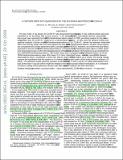| dc.contributor.author | Lin, Jinrong | |
| dc.contributor.author | Nowak, Michael A. | |
| dc.contributor.author | Chakrabarty, Deepto | |
| dc.date.accessioned | 2013-01-08T15:44:53Z | |
| dc.date.available | 2013-01-08T15:44:53Z | |
| dc.date.issued | 2009-11 | |
| dc.date.submitted | 2009-04 | |
| dc.identifier.issn | 0004-637X | |
| dc.identifier.issn | 1538-4357 | |
| dc.identifier.uri | http://hdl.handle.net/1721.1/76188 | |
| dc.description.abstract | The low-mass X-ray binary 4U 2129+47 was discovered during a previous X-ray outburst phase and was classified as an accretion disk corona source. A 1% delay between two mid-eclipse epochs measured ~22 days apart was reported from two XMM-Newton observations taken in 2005, providing support to the previous suggestion that 4U 2129+47 might be in a hierarchical triple system. In this work, we present timing and spectral analysis of three recent XMM-Newton observations of 4U 2129+47, carried out between 2007 November and 2008 January. We found that except for the two 2005 XMM-Newton observations, all other observations are consistent with a linear ephemeris with a constant period of 18 857.63 s; however, we confirm the time delay reported for the two 2005 XMM-Newton observations. Compared to a Chandra observation taken in 2000, these new observations also confirm the disappearance of the sinusoidal modulation of the light curve as reported from two 2005 XMM-Newton observations. We further show that, compared to the Chandra observation, all of the XMM-Newton observations have 40% lower 0.5-2 keV absorbed fluxes, and the most recent XMM-Newton observations have a combined 2-6 keV flux that is nearly 80% lower. Taken as a whole, the timing results support the hypothesis that the system is in a hierarchical triple system (with a third body period of at least 175 days). The spectral results raise the question of whether the drop in soft X-ray flux is solely attributable to the loss of the hard X-ray tail (which might be related to the loss of sinusoidal orbital modulation), or is indicative of further cooling of the quiescent neutron star after cessation of residual, low-level accretion. | en_US |
| dc.description.sponsorship | United States. National Aeronautics and Space Administration (Grant NNX08AC66G) | en_US |
| dc.description.sponsorship | United States. National Aeronautics and Space Administration (Grant SV3-73016) | en_US |
| dc.language.iso | en_US | |
| dc.publisher | IOP Publishing | en_US |
| dc.relation.isversionof | http://dx.doi.org/10.1088/0004-637x/706/2/1069 | en_US |
| dc.rights | Creative Commons Attribution-Noncommercial-Share Alike 3.0 | en_US |
| dc.rights.uri | http://creativecommons.org/licenses/by-nc-sa/3.0/ | en_US |
| dc.source | arXiv | en_US |
| dc.title | A Further Drop Into Quiescence By The Eclipsing Neutron Star 4U 2129+47 | en_US |
| dc.type | Article | en_US |
| dc.identifier.citation | Lin, Jinrong, Michael A. Nowak, and Deepto Chakrabarty. “A Further Drop Into Quiescence By The Eclipsing Neutron Star 4U 2129+47.” The Astrophysical Journal 706.2 (2009): 1069–1077. | en_US |
| dc.contributor.department | Massachusetts Institute of Technology. Department of Physics | en_US |
| dc.contributor.department | MIT Kavli Institute for Astrophysics and Space Research | en_US |
| dc.contributor.mitauthor | Lin, Jinrong | |
| dc.contributor.mitauthor | Nowak, Michael A. | |
| dc.contributor.mitauthor | Chakrabarty, Deepto | |
| dc.relation.journal | Astrophysical Journal | en_US |
| dc.eprint.version | Author's final manuscript | en_US |
| dc.type.uri | http://purl.org/eprint/type/JournalArticle | en_US |
| eprint.status | http://purl.org/eprint/status/PeerReviewed | en_US |
| dspace.orderedauthors | Lin, Jinrong; Nowak, Michael A.; Chakrabarty, Deepto | en |
| dc.identifier.orcid | https://orcid.org/0000-0001-8804-8946 | |
| mit.license | OPEN_ACCESS_POLICY | en_US |
| mit.metadata.status | Complete | |
